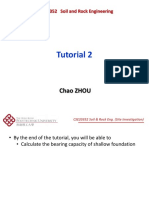Assignment -Boundary Layer Theory
Uploaded by
vipashyanasameerk18Assignment -Boundary Layer Theory
Uploaded by
vipashyanasameerk18BOUNDARY LAYER THEORY
Assignment
1. Define and derive the expression for Energy thickness.
2. Given the velocity distribution in a laminar boundary layer on a flat plate as:
𝑢 3 𝑦 1 𝑦 3
= ( )− ( )
𝑈 2 𝛿 2 𝛿
Obtain expression for the Displacement thickness, Momentum thickness & Energy
thickness.
3. Write short note on:
i. Laminar Sub Layer
ii. Boundary Layer separation & its control measures
iii. Terminal velocity of body
iv. Magnus effect
4. A flat plate 2 m long & 1.5 m wide is towed at 30 kmph in a water. The drag & Lift
coefficients are found to be 0.20 & 0.60 respectively. Calculate i) the resultant force
on the plate & ii) the power required to keep the plate in motion.
5. A kite has a plan form area of 0.25 m2 & is flying in a wind of velocity 25 kmph. The
kite has a net weight of 1.2 N. When the string is inclined at an angle of 15o to the
vertical, the tension in the string was found to be 3.0 N. evaluate the coefficients of lift
& drag. Take ρair = 1.115 kg/m3.
You might also like
- CHG 503 Tutorial 2 - Boundary Layer - 220129 - 215132No ratings yetCHG 503 Tutorial 2 - Boundary Layer - 220129 - 2151323 pages
- Department of Applied Physics Question Bank-I Semester PH6151-Engineering Physics - I UNIT-II - Properties of Matter and Thermal PhysicsNo ratings yetDepartment of Applied Physics Question Bank-I Semester PH6151-Engineering Physics - I UNIT-II - Properties of Matter and Thermal Physics4 pages
- Set1 Physics Ms MidTerm 1 2021 Teacher.co .Ke F3 ExamNo ratings yetSet1 Physics Ms MidTerm 1 2021 Teacher.co .Ke F3 Exam5 pages
- Foundation Engineering Assignment - 1 Shallow Foundation: Department of Civil EngineeringNo ratings yetFoundation Engineering Assignment - 1 Shallow Foundation: Department of Civil Engineering2 pages
- MEC520T Design For Vibration Control. Assignments 1 and 2No ratings yetMEC520T Design For Vibration Control. Assignments 1 and 24 pages
- 10 Boundary Layer Drag Lift Physical Model Tutorial SolutionNo ratings yet10 Boundary Layer Drag Lift Physical Model Tutorial Solution20 pages
- TUTORIAL - 2 and 3 - FME - FPE 111 - PHYSICS 1A - 2021-2022No ratings yetTUTORIAL - 2 and 3 - FME - FPE 111 - PHYSICS 1A - 2021-20224 pages
- Mid-Term Test Time Allowed: Total Marks: Materials Allowed: Textbook, Lecture Notes and University Approved Calculator NotesNo ratings yetMid-Term Test Time Allowed: Total Marks: Materials Allowed: Textbook, Lecture Notes and University Approved Calculator Notes2 pages
- Analyzing Riskes and Maximum Altitude Metrics in Human Free Fall From Extreme AltitudesNo ratings yetAnalyzing Riskes and Maximum Altitude Metrics in Human Free Fall From Extreme Altitudes10 pages
- Ex. 3 - Aeroelastic Static Stability 16-19/10/2018: Ex. 3a - Divergence Analysis With 1 DOFNo ratings yetEx. 3 - Aeroelastic Static Stability 16-19/10/2018: Ex. 3a - Divergence Analysis With 1 DOF2 pages
- Boundary Layer and Flow Past Through Submerged Body Numericals - KN DulalNo ratings yetBoundary Layer and Flow Past Through Submerged Body Numericals - KN Dulal12 pages
- 20201002134504-Round 1 Section 2 Nov 2019No ratings yet20201002134504-Round 1 Section 2 Nov 201916 pages
- Jawaban Mekflu 9 Februari 2021 (English)No ratings yetJawaban Mekflu 9 Februari 2021 (English)9 pages
- Phy-xi Target Paper (2025) -Zain'II GroupNo ratings yetPhy-xi Target Paper (2025) -Zain'II Group7 pages



























































